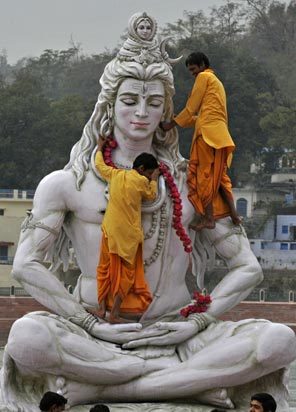Offbeat India Tours
Yoga Tourism in India
Yoga is a Sanskrit word meaning – Union of Aatman (individual Self) with Brahman or parmaatma (Universal Self). The Sanskrit root for “yoga” is “yuj” i.e., “to bind or yoke” [to the Brahman].
Actually, Yoga pertains to a high level of mental, physical and spiritual discipline. The aim of yoga, rather of the individual practicing yoga, is the realization of a condition of unqualified assimilation and harmony with the divine while contemplating the Supreme Being. The ends of yoga are diverse, ranging from an improved health to attaining moksha. A person who carries out yoga practice or dedicatedly adheres to the yogic way of life is called a yogi.Generally, when one talks about Yoga, the person refers to a system which follows the Yoga Sutras of Patanjali (2ndcentury BC), which is also called the Rāja Yoga (or Ashtanga Yoga).
The fundamental purpose of Yoga is to awaken the Kundalini, i.e., a “corporeal energy” – an unconscious, instinctive, or libidinal force or Shakti, which lies coiled at the root of the spine. It is visualized as a sleeping serpent. The Kundalini inherits the sacrum bone, which happens to be the large, triangular bone at the base of the spine and at the upper and back part of the pelvic cavity, in 3½ coils and is described as the lingering, intense urge of pure desire. Kundalini literally means coiled.
The Kundalini levitates from its base, the muladhara chakra, through its subtle conduit, traversing the base of the spine (called Sushumna), to reach the top of the head so as to assimilate with the sahasrara, that is crown chakra. The Kundalini Shakti could be conceived as the power hidden, i.e., our aatma which rises towards our (sahasrara) head, till it merges with the Brahman, the Supreme Being. Then the seeker progressively gets absorbed in deep contemplation and infinite bliss, i.e. a position of Samadhi.
This arousing of Kundalini is considered to be the only way to achieve Divine Wisdom. This Self-Realization in fact, is the other name of realizing the Divine Wisdom or self-knowledge. The arousing of the Kundalini reveals itself as “awakening of inner knowledge” and brings with itself Samadhi, i.e., a state of “Sat-Chit-Anand” or “the incandescent knowledge of final truth, a state of supreme consciousness, and a state of ultimate bliss.” On its way up, the Kundalini or the (symbolic) serpent is in a state of various knots (chakras) which have to be un-knotted. Only a wise, highly evolved, and spiritually inclined guru can help in solving the intricacies involved.
The seven primary chakras are as follows –
i) Muladhara Chakra – Base or Root Chakra (ovaries/prostate)
ii) Swadhisthana Chakra – Sacral Chakra (last bone in spinal cord)
iii) Manipura Chakra – Solar Plexus Chakra (navel area)
iv) Anahata Chakra – Heart Chakra (heart area)
v) Vishuddha Chakra – Throat Chakra (throat and neck area)
vi) Aagya Chakra – Brow or Third Eye Chakra (pineal gland or third eye)
vii) Sahasrara Chakra – Crown Chakra (top of the head; ‘soft spot’ of a newborn)
The Ashtanga Yoga incorporates its eight components:
Yama – the primary code of behavior, including self-restraints
Niyama – religious commitments to practice, study and dedication
Āsana – synthesis of mind and body through physical postures
Pranayama – management of breath, leading to integration of mind and body
Pratyahara – sublimation of senses of perception through renunciation of objects
Dharana – concentration through focusing of mind
Dhyana – contemplation in solitude that leads to Samadhi
Samādhi – that passive state of idyllic consciousness, a super-conscious state. It is attained when the yogi irrevocably realizes Parmaatma in his (jivaatma) heart.
Yoga Asanas
The yoga asanas are physical postures in rhythm with one’s inner consciousness. They seek to attain a comfortable sitting posture to facilitate meditation, which does not produce any discomfort even if adapted endlessly. These postures also help in revitalizing and harmonizing the basic structure of the human body.
The Functions of Yoga Asana
Asanas primarily perform five basic functions:
Conative – deliberate work outs of the organs of action
Cognitive – recognizing and understanding things
Mental – inner visualization
Intellectual – the ability to think
Spiritual – mystical experiences.
Yoga Tourism in India
Yoga is one of the most popular facets of Indian Civilization that draws a large number of international tourists to the country. However, as a Yoga practitioner is required to follow various dietary restrictions, the Yoga tourists are also expected to adhere to the same regimen. It is therefore advisable that tourists come mentally prepared to follow the prescribed lifestyle in order to enjoy the full benefits of these alternate medicinal systems.
———————————————————————
Outline of Some more off beat India Tours:
Ayurveda Tours in India – Lay people have increasingly come to realize that Ayurveda offers enormous relief in case of ailments related to stress, metabolism related or in case of various chronic problems. More….
Rural Olympics in India – Destination Ludhiana is the buzzword every year during the 1st fortnight of February, when the city attracts more than a million visitors from all over the world to witness the … More …
Poverty Tourism/Tours in India – The world discovered Dharavi in Mumbai because of the movie “Slumdog Millionaire.” The film, which won the coveted Oscar Awards, in fact substantially enlarged the… More…
